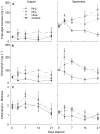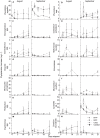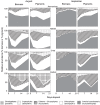Phytoplankton-specific response to enrichment of phosphorus-rich surface waters with ammonium, nitrate, and urea
- PMID: 23349705
- PMCID: PMC3547936
- DOI: 10.1371/journal.pone.0053277
Phytoplankton-specific response to enrichment of phosphorus-rich surface waters with ammonium, nitrate, and urea
Abstract
Supply of anthropogenic nitrogen (N) to the biosphere has tripled since 1960; however, little is known of how in situ response to N fertilisation differs among phytoplankton, whether species response varies with the chemical form of N, or how interpretation of N effects is influenced by the method of analysis (microscopy, pigment biomarkers). To address these issues, we conducted two 21-day in situ mesocosm (3140 L) experiments to quantify the species- and genus-specific responses of phytoplankton to fertilisation of P-rich lake waters with ammonium (NH(4)(+)), nitrate (NO(3)(-)), and urea ([NH(2)](2)CO). Phytoplankton abundance was estimated using both microscopic enumeration of cell densities and high performance liquid chromatographic (HPLC) analysis of algal pigments. We found that total algal biomass increased 200% and 350% following fertilisation with NO(3)(-) and chemically-reduced N (NH(4)(+), urea), respectively, although 144 individual taxa exhibited distinctive responses to N, including compound-specific stimulation (Planktothrix agardhii and NH(4)(+)), increased biomass with chemically-reduced N alone (Scenedesmus spp., Coelastrum astroideum) and no response (Aphanizomenon flos-aquae, Ceratium hirundinella). Principle components analyses (PCA) captured 53.2-69.9% of variation in experimental assemblages irrespective of the degree of taxonomic resolution of analysis. PCA of species-level data revealed that congeneric taxa exhibited common responses to fertilisation regimes (e.g., Microcystis aeruginosa, M. flos-aquae, M. botrys), whereas genera within the same division had widely divergent responses to added N (e.g., Anabaena, Planktothrix, Microcystis). Least-squares regression analysis demonstrated that changes in phytoplankton biomass determined by microscopy were correlated significantly (p<0.005) with variations in HPLC-derived concentrations of biomarker pigments (r(2) = 0.13-0.64) from all major algal groups, although HPLC tended to underestimate the relative abundance of cyanobacteria. Together, these findings show that while fertilisation of P-rich lakes with N can increase algal biomass, there is substantial variation in responses of genera and divisions to specific chemical forms of added N.
Conflict of interest statement
Figures






References
-
- Vitousek PM, Aber JD, Howarth RW, Likens GE, Matson PA, et al. (1997) Human alteration of the global nitrogen cycle: Sources and consequences. Ecological Applications 7: 737–750.
-
- Millennium Ecosystem Assessment (2005) Ecosystems and human well-being, vol. 1. Current state and trends: Findings of the condition and trends working group (Millennium Assessment Series). Washiington, DC: Island Press.
-
- Foy RH, Smith RV, Jordan C, Lennox SD (1995) Upward trend in soluble phosphorus loadings to Lough Neagh despite phosphorus reduction at sewage treatment works. Water Research 29: 1051–1063.
Publication types
MeSH terms
Substances
LinkOut - more resources
Full Text Sources
Other Literature Sources
Miscellaneous

